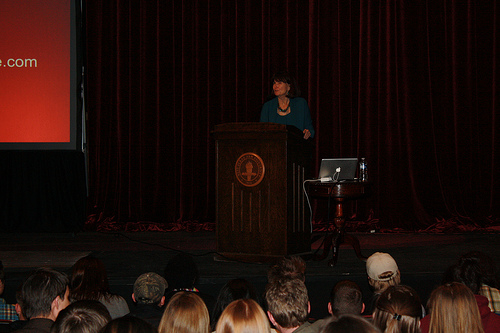
The second event of Communication Week on Feb. 15 featured a lecture by visiting scholar Dr. Jean Kilbourne. Dr. Kilbourne is internationally recognized for her work on alcohol and tobacco advertising. Dr. Kilbourne has also closely studied the image of women in advertising. She has been featured on television shows such as The Today Show and Oprah.
The Branding Iron Theatre was packed with students, faculty and local residents who came to see Dr. Kilbourne speak. The lecture lasted about 45 minutes and featured a presentation of different advertisements. Although the lecture was short, it made an impact on the audience.
Dr. Kilbourne opened the lecture with a few surprising facts. According to her research, the average person sees about 3,000 advertisements a day and spends two years of their life watching TV commercials. Babies at the age of six months can already begin to recognize brand images.
As a result of the advertising industry’s message, “we live in a toxic cultural environment,” Kilbourne said.
Her presentation featured ads that had blatant photoshopping, including a promotional poster for Pretty Woman and a recent Ralph Lauren ad, which actually got the model fired because “she was too fat.”
Models are all too aware of the photo-shopping phenomenon. Cindy Crawford once commented that “[She] wished [she] looked like Cindy Crawford.”
While a woman’s world is obsessed with thinness, Dr. Kilbourne pointed out that in a man’s world, masculinity is emphasized at an early age and “bigger is better.”
“There is nothing wrong with wanting to be attractive,” Kilbourne said. “It’s wrong how narrow and stereotypical beauty is made to be.”
Dr. Kilbourne also presented less obvious forms of discrimination in advertisement, including women of color, children, elderly people and female athletes. She pointed out how women of color are made to look animalistic in fashion ads and how body language can promote a sense of “infantilization” for women.
“They promote a powerful double standard,” Kilbourne said. “Girls have to be sexy yet innocent and experienced yet virginal.”
The presentation was eye-opening for Precious Wilson, an African American senior advertising and public relations major.
“It’ll change the way I look at ads,” Wilson said. “I want to work in fashion [after graduation] and what hit me was [what Kilbourne said] about women of color because it’s so true.”
Shannon Gray, junior advertising/public relations major, was more surprised at the advertising industry’s portrayal of children.
“[What impacted me] was how she talked about children being sexualized, like in pageants,” Gray said.
Dr. Kilbourne was one of the first to start looking at this side of the advertising industry, and it has grown into a burgeoning form of study. However, many wonder if the idea of “sex sells” in the advertising agency will still prevail.
“It depends on whether or not we do something about it,” Bob Buckles, sophomore general studies major, said. “Boycotting [the products] or asking [the agencies] to change what they put out [can help].”







